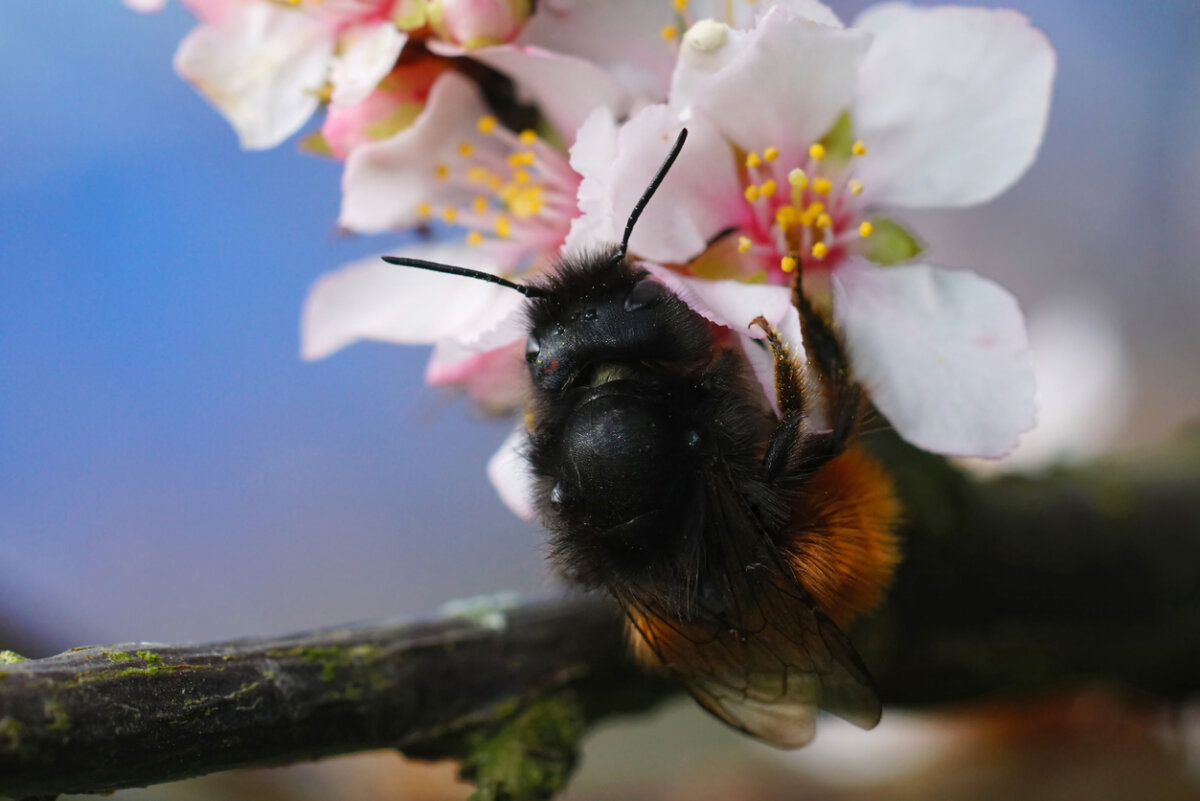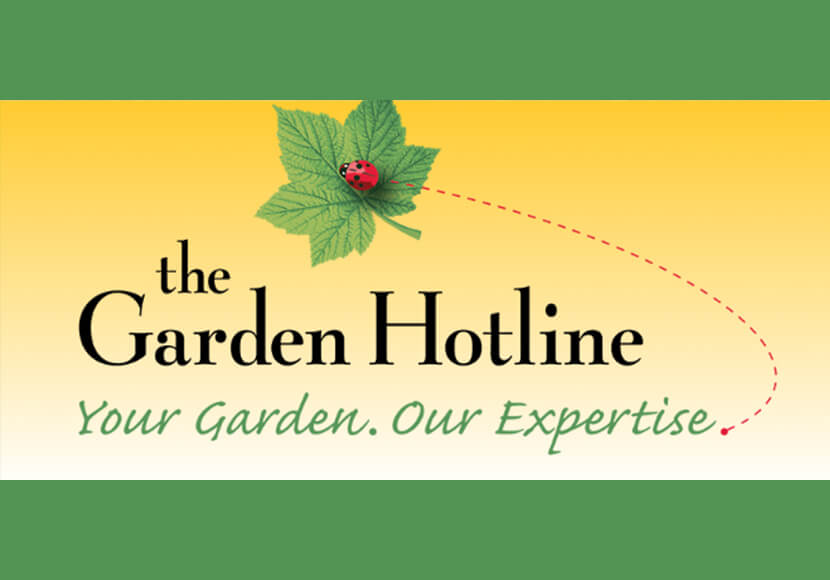
You can help mason bees and other pollinators by growing native plants, reducing or eliminating pesticides and providing habitat.
This is the time of year to think about mason bees. These small, solitary, nonaggressive bees are most active in early spring. This makes them great pollinators for fruit trees, which flower in spring.
Mason bees are amazing pollinators. Each mason bee visits around 1,800 to 2,000 flowers a day, and they pollinate 95-99% of them. In comparison, a honeybee may visit 700 flowers a day and pollinate about 5% of them. They are called mason bees because they use clayey mud to build protective walls for their cocoons.
If you want to encourage mason bees in your yard, now is a good time to take action. Many of the actions you take to support mason bees will also help other pollinators, such as other native bees, butterflies, honeybees and bumble bees.
Ways to help mason bees and other native pollinators
Add native plants to your yard
Mason bees and other pollinators need food, primarily nectar. Choose a variety of plants that bloom at different times of year so pollinators have food throughout the growing season. Mason bees need flowers from late March through May. Bee researchers found that “the more flowers that are in bloom at the same time, the greater the population of these valuable early-season pollinators,” according to the Seattle Times.
Here are 10 Pacific Northwest native plants for pollinators from Swansons Nursery.
- California hazelnut (Corylus cornuta var. californica)
- Vine maple (Acer circinatum)
- Bigleaf maple (Acer macrophyllum)
- Trillium (Trillium sp.)
- Redwood violet (Viola sempervirens)
- Salal (Gaultheria shallon)
- Alpine strawberry (Fragaria vesca)
- Trailing blackberry (Rubus ursinus)
- Oregon grape (Mahonia aquifolium)
- Western buttercup (Ranunculus occidentalis)
And here are links to a few other plant lists.
- Native Plants For Pollinators and Beneficial Insects: Maritime Northwest Region, Xerces Society (pdf)
- Pollinator Plants for Northwest Washington, WSU Extension (pdf)
- 12 plants to entice pollinators to your garden, OSU Extension Service
- Plants for Pollinators: A Regional Guide for Farmers, Land Managers, and Gardeners in the Pacific Lowland Mixed Forest Province, Pollinator Partnership and NAPPC (pdf)
Reduce or eliminate your use of pesticides
This includes insecticides, fungicides, and herbicides. An insecticide called imidacloprid is especially insidious. According to Science, the pesticides “disrupt learning and memory in honey bees and several studies have shown solitary bees suffer the same kind of damage.”
Research done on blue orchard mason bees found that “bees that had consumed [imidacloprid] pesticides had 30% fewer offspring, compared with bees that had grown up without pesticides,” according to Science. Over two generations, the damage added up. Bees that were exposed to pesticides as larvae and then as adults would have about 75% fewer offspring than those that had not been exposed.
The best way to reduce or eliminate pesticide use is through prevention.
Grow a healthy lawn. Many of our clients want to go organic but hate lawn weeds. A thick, healthy lawn will resist weeds and moss. Our Bee Friendly Lawn program provides guidelines for how to grow a healthy lawn and help our native bees. We will not use weed and moss killer on lawns that are not maintained properly.
Keep plants healthy. Choose plants that will thrive in our local conditions, such as native plants and other plants adapted to our climate. Place them in your landscape properly, such as giving them the right amount of sun and shade. Give them enough water (but not too much), and use organic mulch and fertilizer to protect and feed them.
Monitor pest populations and identify pests accurately. Regularly check your yard for pests to catch problems early. Look for signs of damage, such as chewed leaves or brown spots, and look for insects. Check out this photo gallery of some common pests along with less-toxic approaches to manage them. Here is a pocket guide to common Pacific Northwest pests and more insect and pest resources.

Contact the Garden Hotline for free expert advice about garden problems.
Use the least-toxic methods to manage pests. Encourage birds and beneficial insects that eat pests. Spray off aphids with water. Choose least-toxic pesticides when needed, such as neem oil, insecticidal soap and Bacillus thuringiensis (Bt).
You can get free advice for your specific plant or pest problem from the Garden Hotline. Call the hotline at (206) 633-0224 or send an email. You may also want to look up specific pest control products by brand name in the Grow Smart Grow Safe guide.
Provide clean water and mud
Pollinators need water for many purposes, including drinking, cooling and reproduction, said University of Maine Cooperative Extension. Butterflies, for example, will gather and sip at shallow pools, mud puddles or even birdbaths.
You may already have a natural water source, such as a pond or stream. If not, you can create a water source. This could be a birdbath, fountain or water garden. It could simply be a hanging water bottle that slow drips or a small container of water. Be sure to change the water in all artificial water sources 2-3 times per week, especially during warm weather when mosquitoes are breeding. It’s also helpful to place rocks in your birdbath or small container for insects to land on when they are collecting water.
Mason bees need a puddle of bare, muddy soil to pack into the openings of their nests. With climate change, our springs are sometimes not reliably damp, so you may need to provide a reliable source of mud. A puddling dish will provide water for bees to use for making mud. It is helpful to sprinkle some fine sand in the dish and locate it in a sunny area where it will be easy to locate.
Read more about water sources for pollinators from the Xerces Society.
Provide habitat for mason bees
Bee houses
In the past we have recommended buying bees from Crown Bees or renting them from Rent Mason Bees. From both firms you can get tubes containing mason bee larvae, nesting tubes or blocks, and a small bee house to hang on a sunny outdoor wall.
While using bee houses is a great way to help mason bees, there is increasing concern that raising solitary bees in close quarters creates problems. “Not only do dense bee settlements attract disease, mold and fungus, but those woodpeckers, parasitic wasps and mites also admire them,” said Honey Bee Suite.
Many species of birds and rodents will prey upon mason bees, Crown Bees said. The company provides tips for how to use wire mesh or other materials to protect the bee houses.
Problems with parasitic wasps, mites and diseases generally occur when the nesting tubes or blocks are not cared for properly. Both Rent Mason Bees and Crown Bees are taking steps to counteract these problems. Rent Mason Bees does meticulous cleaning when bees are returned to them in the fall. Crown Bees individually inspects and cleans each cocoon. Here are detailed instructions about how to clean cocoons.
Plants with hollow stems
Another way to help mason bees and leafcutter bees is to grow plants with hollow stems. Several characteristics make upright hollow stems great bee housing, according to Honey Bee Suite.
- The stems are spread further apart, making it more difficult for diseases to spread and for predators, such as birds and wasps, to find the bees. Because they are spread out, it is also more time-consuming for predators to eat them.
- The stems naturally fall over and start to decompose after a couple of years. Adults will move on to other homes. This keeps pathogen levels low.
Some bees, such as carpenter bees, like stems with soft, pithy centers. They chew the pith into a paste to use to build partitions between egg chambers.
Year One
Choose and plant the right plants. Honey Bee Suite’s list includes lovage, elderberry, blackberry, teasel, drumstick allium, mountain mint, goldenrod, sunflowers, joe-pye weed and swamp milkweed. Contact your local extension agent or garden club for advice on appropriate plants for our area.
At the end of the first growing season, use a sharp tool to cut the stems back to about 12 to 18 inches high, leaving them in the ground. Use a sharp tool to make a clean cut for smooth and straight openings. Another option, according to University of Minnesota Extension, is to cut stems to about eight inches and tuck them in the crotch of a tree.
Year Two
In spring, bees that are active will nest in the stems you left standing. “They will lay eggs in the stem and provision each egg with a nutritious ball of pollen and nectar,” said Tufts Pollinator Initiative. Bees will develop from eggs into larvae and adults that hibernate through winter.
Leave these stems standing all year. You can also start more plants for the next season.
At the end of the growing season, cut back the new, green stems produced this year for next year’s bees to use.
In the late fall or early winter, some stems may bend over or fall to the ground. Since we have wet winters, you may want to cut the stems at ground level and store them in a cool, dry place. Put them out in spring, but use an emergence box so the bees won’t reuse the stems.
An emergence box is an empty box with a lid and a small hole where bees can fly out. Bees prefer to lay their eggs in sunny locations. Most will not want to go into the dark box to find their old nesting tube but will use a new hollow stem. Honeybee Suite has more information about emergence boxes.
Year Three
In spring the bees will emerge from the hollow stems you planted the first year, and many will nest in the stems you planted the second year. “Now you’re on a roll,” said Honey Bee Suite. “You just have to keep going and you should have plenty of healthy bees to pollinate your orchard and garden crops.”
Provide habitat for bees and pollinators
Different pollinators need different types of habitat for their shelter and nests.
- Dead wood, such as stumps, snags, logs and piles of twigs or branches, provides nesting habitat for a variety of pollinators such as bees, wasps, beetles and ants.
- Many solitary bees will nest in the pith of stems and twigs.
- Many ground-nesting bees need bare, undisturbed, well-drained soil.
- Plant debris provides homes for overwintering bees and other beneficial insects such as spiders, ladybugs and beetles. This could include fallen leaves, dead plant stems, dried seed pods and faded ornamental grasses.
Read more about nesting and overwintering habitat from the Xerces Society and about creating pollinator habitats from the Washington Department of Fish and Wildlife.
We can help
We offer services to help you create and maintain a landscape that is friendly to mason bees and other pollinators. For example, we can design and install a landscape featuring native plants that provide food and shelter. Our natural lawn, tree and shrub care program will improve plant health, reducing or eliminating the need for pesticides. Contact us to learn more.
